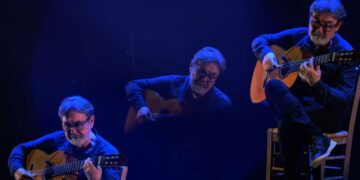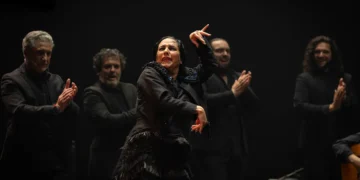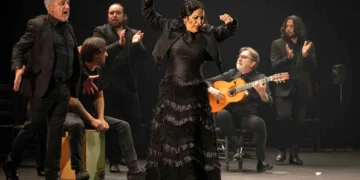|
|
|
|
Photos: Ana Palma Juan Campallo, Juan Pinilla The first day of March, ninth of the Festival de Jerez, began with an acoustic recital with guitarist Juan Campallo in the first part, and singer Juan Pinilla in the second, both prizewinners in their respective specialties at the last La Unión contest. Juan Campallo, winner of the Bordón Minero, and brother of Rafael and Adela, played rondeña, taranta, alegrías in E and bulerías, with beautiful compositions in the contemporary line of delicate harmonies, subtlety and a soft touch. | |
 |
 |
Last year singer Juan Pinilla managed to bring the Lámpara Minera, highest cante prize of La Unión, to his hometown of Granada after four tries, and he is a worthy winner because this young man has grown artistically since that time. Jerez is not an easy arena for anyone in flamenco, much less a singer specialized in the melodious cante of eastern Andalusia. Jerez aficionados were conspicuously absent among the audience, but the hall filled with many flamenco fans from outside who were able to witness a surprising recital. With all the sincerity that characterizes him, and all the sweetness of his idol, Bernardo el de los Lobitos, Pinilla sang a series of forms, some nearly obsolete, lovingly naming and explaining each one: malagueña de Chacón, fandango de Almería, fandango de madrugá de Manolo el Ruso, malagueña de Juan Breva, fandango de Córdoba, de Frasquito Yerbabuena, caña dedicated to the memory of Cobitos “who was born in Jerez but went to Granada”, tangos de Sacromonte to the memory of Loles del Cerro and María la Jardín, elderly singers both of whom died over the last few days, levantica “to justify the Lámpara”, and to end, he apologized because “I do my certain cantes, I haven’t come to Jerez to sing bulerías”, and interpreted a farruca. Few singers would be capable of such a recital, much less one so young. And the audience responded with the biggest ovation seen in this hall of the Palacio de Villavicencio since I’ve been attending the Festival de Jerez. Outside the dressing-room people lined up to have their picture taken with the singer who conversed fluently with his admirers in German, French and English. A surprising evening of cante that was accompanied by the excellent guitar of Luis Mariano.
Eva Yerbabuena “Santo y seña”
Teatro Villamarta 2100h
Text: Estela Zatania
Dance: Eva Yerbabuena. Corps de ballet: Juan Carlos Cardoso, Eduardo Guerrero, Alejandro Rodríguez, Juan Manuel Zurano. Cante: Enrique Soto, Pepe de Pura, Jeromo Segura, José Valencia. Guitar: Paco Jarana, Manuel de la Luz. Percussion: Raúl Domínguez. Sax-flute: Ignacio Vidachea.
In her work “Santo y Seña”, Eva Yerbabuena employs a novel concept: she just dances flamenco. No falling leaves, no street-sweepers, no poets or chains, no singers made to stand in shower stalls or sing on their knees. I seriously doubt she did it as a result of having read my many reviews underlining the pretenciousness of her works and the excellence of her dancing, but this time, she got it right. There are still theatrical touches, but rather that being the center of attention, they fulfill a decorative or incidental function.
In fact, the “work” is not a work at all, but a medley of some of the best dances from her earlier works. Eva is a dancer who sticks to set, perfectly rehearsed choreographies – it’s the only way to carry out many of the best touches that depend on the complicity of guitarists and singers – but she has the admirable gift of disguising that lack of spontaneity. She begins bravely with siguiriyas with singer José Valencia’s dynamic singing, then another verse from Pepe de Pura standing in an aisle among the devoted audience who react with shouts of “ole!” to the dancer’s every bat of an eyelash.
The farruca with four male dancers offers the attraction not only of interesting choreography, but of the exquisitely disciplined group and the beautiful music of Paco Jarana. Cantiñas with bata de cola. The four voices contrast and complement each other: the sheer power of José Valencia, the sweetness of Pepe de Pura, the swift melisma of Jeromo Segura and the Jerez sound of Enrique Soto.
A “jaleo”, or bulería de Extremadura as it used to be called, then another group dance of the men, as finely worked as the first one, is followed by tientos with tango, and Eva’s famous soleá is distilled to a free-form dance in slow-motion where the cante takes center stage, an elegant gesture with which Yerbabuena seems to be saying “ you’ve already seen my soleá many times”, having the effect of triggering visual memories that mentally reconstruct the choroegraphy.
“Santo y Seña” confirms that Eva Yerbabuena has accepted her true identity as flamenco dancer, and for this, all followers of the art may be profoundly grateful, because this kind of talent should not be squandered on experimental theater and dubious philosophical contrivances.
Rafaela Carrasco
“ConCierto gusto”
Sala la Compañía, 12 midnight
Text: Manuel Moraga
Dance: Rafael Carrasco. Cante: Antonio Campos, Antonio Núñez “El Pulga”. Guitar: Jesús Torres, Juan Requena, Juan Antonio Suárez “Canito”. Percussion: Nacho Ariman

Some artists are naturally inquisitive or experimental-minded. They learn, absorb, digest, express…and move on to the next thing with little fanfare. It’s a much more complex, risky and dynamic process. Risk with the audience, with the critics and above all, with themselves: a continuous self-testing of one’s doubts and insecurities. Rafaela chose this path, and one of her stops along the journey was the Sala Compañía where once again she highlighted her flamenco beginnnings, but in her own peculiar style. She appears alone, or perhaps lonely, to be constantly interacting with the singer and guitarist. And I underline “interacting”, because her relationship with these two elements goes way beyond that of simple accompaniment. There is actual dialogue.
To palliate Rafaela’s lonliness, in this case physical, “ConCierto Gusto” alternates dance with vocal and guitar solos. And the musicians get high marks, especially gutarist Canito, and percusionist and composer Nacho Arimany for his sensitivity and originality (he has recently presented his first record which is a jewel for any music-lover). Arimany and Rafaela do a beautiful piece with a diversity of elements including jugs and vocals, admirably danced by the woman from Seville.
The entire show has an austere look. The lonliness of the stage, endings that avoid the spectacular, lukewarm illumination and dark colors. It would be hard to choose the best dance, but the soleá was certainly of high quality. Rafaela’s newfound depth goes well with this style. Her arms are heavy, despite the agility with which she moves them. The ending fandangos are also noteworthy; arms, head, hips, feet…body. The questing body of Rafaela Carrasco.
Descubre más desde Revista DeFlamenco.com
Suscríbete y recibe las últimas entradas en tu correo electrónico.


 Eva Yerbabuena “Santo y seña”
Eva Yerbabuena “Santo y seña”























